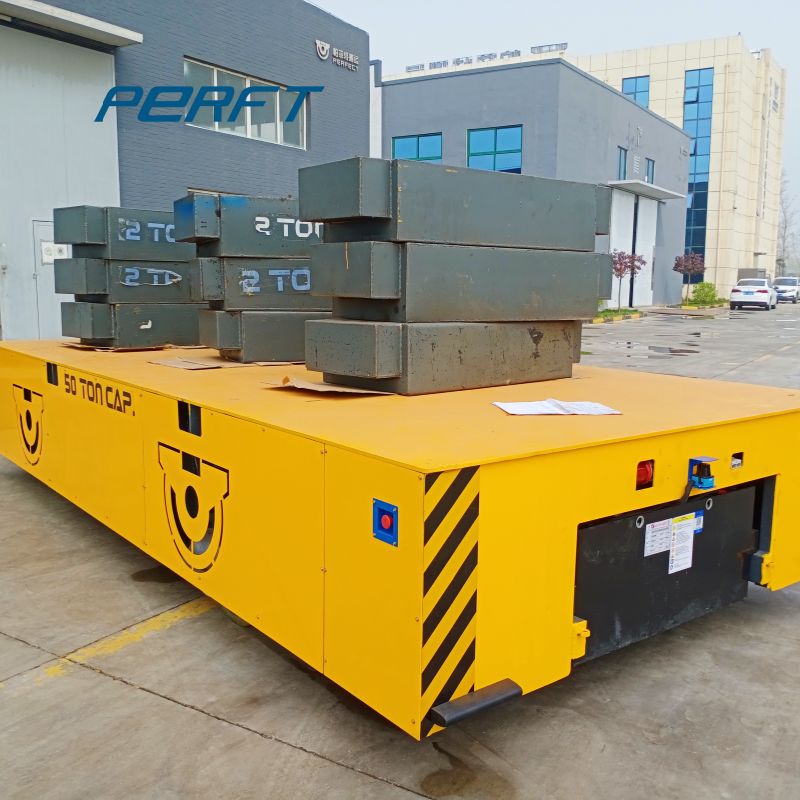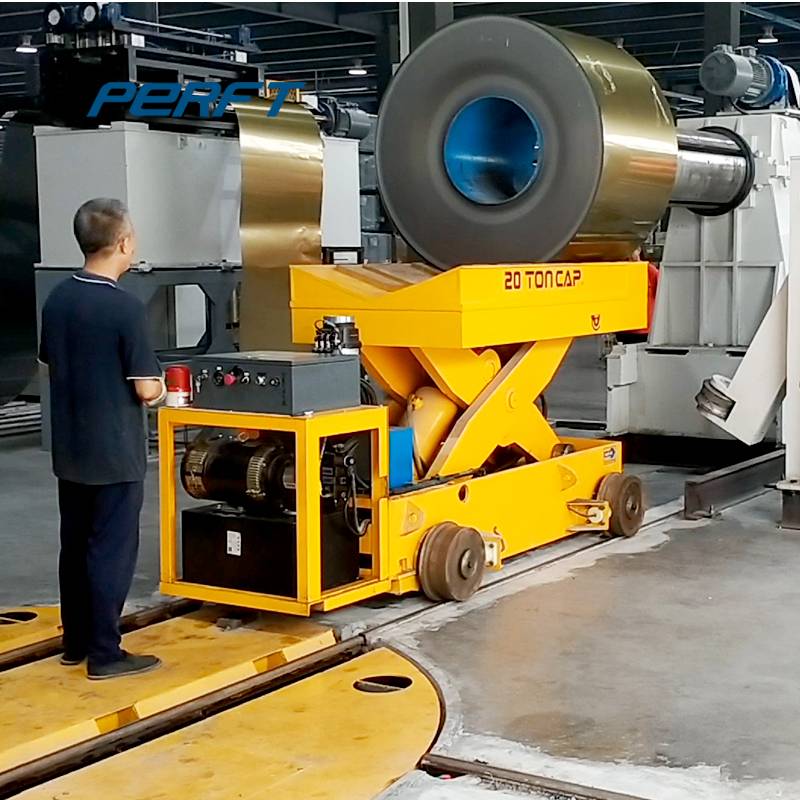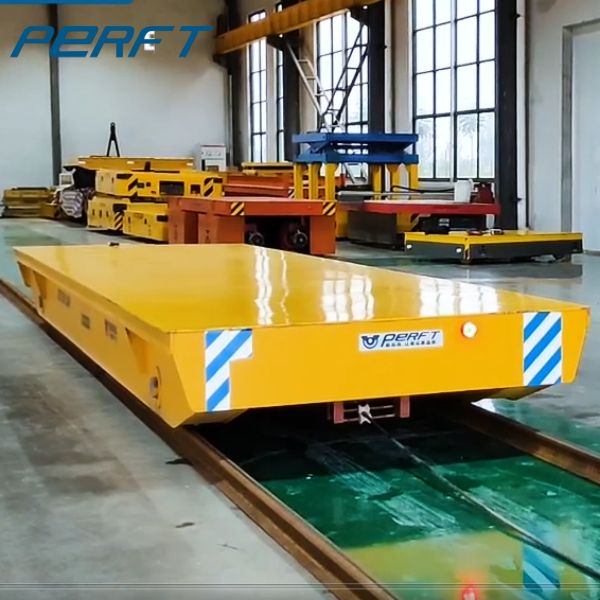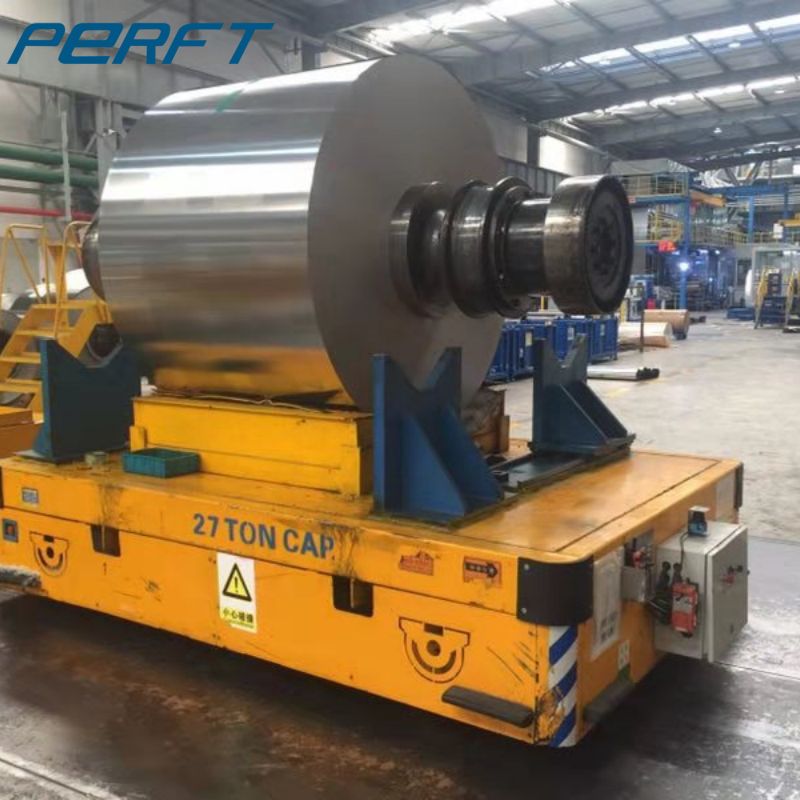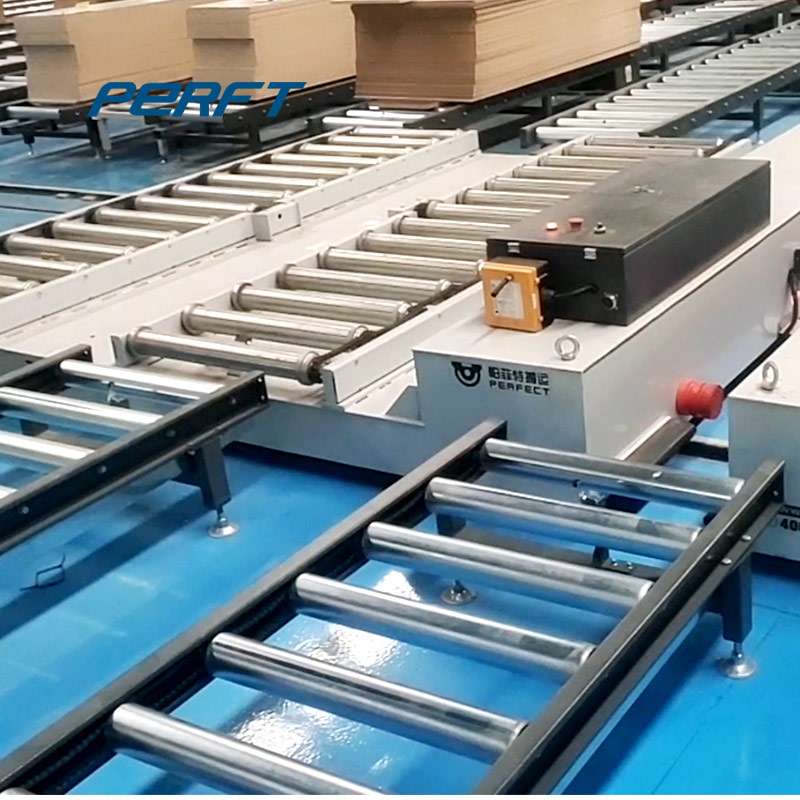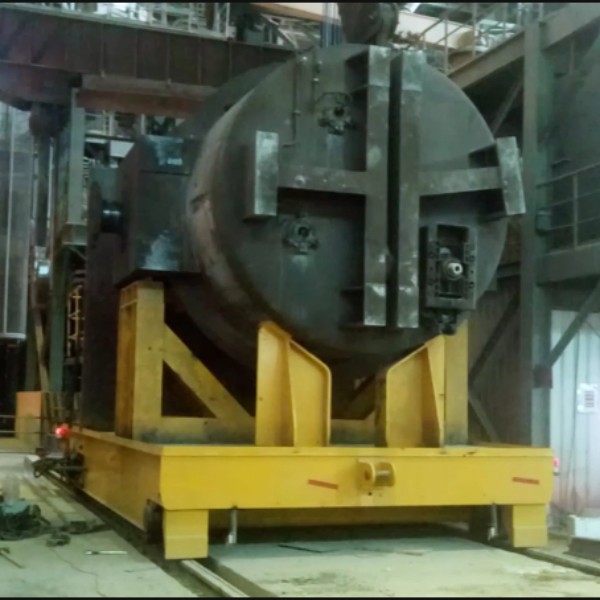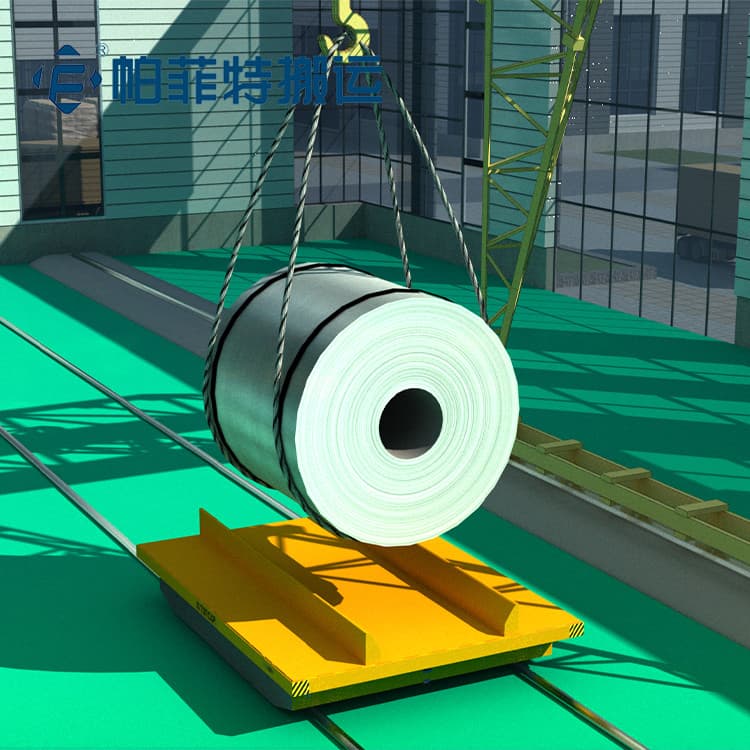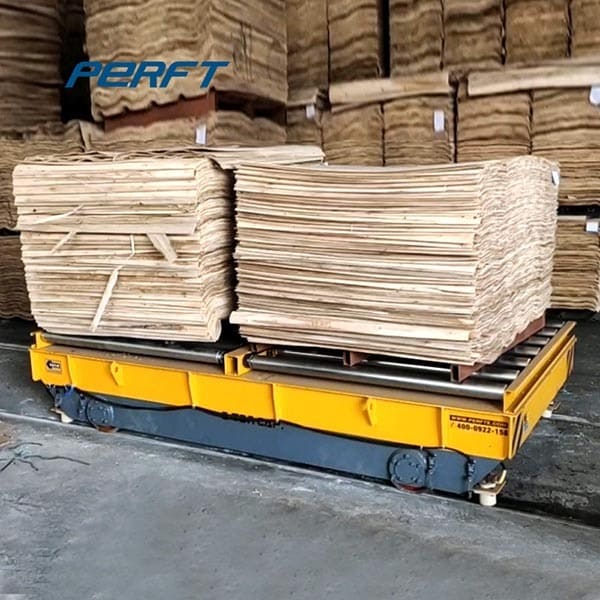Battery Transfer Cart
I. Introduction
Definition of battery transfer cart
Battery Transfer Cart is a transfer cart powered by battery, the battery is installed inside the cart body, and the power supply provides power to the DC traction motor through the electrical control system, so that the transfer cart can start, stop, move forward, backward and speed control smoothly. The series of flat cars can be used on the vertical track, L-type track, S-type track, arc track and explosive, ferrying occasions; battery transfer car can be added with a hydraulic lifting system; DC motor on the transfer car has the advantages of a smooth start, large starting torque, small impact on the reducer, low voltage, long service life, etc.; compared with other series of transfer car, its running distance is not limited, and the requirements for track laying are not high. It is suitable for various transportation occasions. However, the battery needs regular maintenance. Due to the limited capacity of the battery, its use time is limited.
Importance of battery transfer carts in material handling operations
Unlike forklifts, pallet trucks, and other trucks, battery transfer trucks are essential for industrial material handling, helping to improve efficiency, reduce downtime, enhance safety, and increase productivity.
Efficient battery maintenance: Battery maintenance is relatively simple, regular charging and inspection are sufficient, and no complicated maintenance is required.
It also has the convenience of automatic charging or replacement at any time, ready to use.
Reduce downtime: The transfer truck can be prepared with spare batteries to reduce equipment downtime and easily and quickly replace batteries to ensure equipment is always available.
Improved safety: The battery transfer vehicle has no extra power supply lines to lay, reducing the safety hazard of wire dragging.
Increase productivity: Not only can you provide backup batteries, but you can also recharge them automatically, during non-working hours, at a designated location, to increase productivity.
Battery Transfer Cart: What Is It?
Types of Battery Transfer Carts
Rail-guided transfer carts
Rail-guided transfer carts battery powered are usually used for heavy material handling on fixed routes in industry, mostly for large, heavy, shaped material handling in production lines.
Steerable transfer carts
Battery-powered steerable transfer carts have wheels that rotate 360° in place and can be moved in any direction, making them flexible enough to meet most industrial indoor and outdoor heavy lifting needs. They can move in any direction and are ideal for indoor and outdoor use.
Die transfer carts
Battery-powered steerable transfer carts are professional transfer carts for metalworking industry mold handling, the irregularity of the mold itself makes it in handling, high demand, mold transfer carts are specially made for heavy mold handling and replacement applications.
Coil transfer cart
Coils of heavy steel, aluminum, paper, etc. in steel mills, paper mills and other industries that need to transport large and heavy items generally require relatively wide storage warehouses with relatively inconvenient power supply facilities, and battery trucks, which are a good solution to the problem of no power supply.
Components Of One Battery Transfer Cart
Frame
Handling capacity (T) 5T 10T 15T 20T 30T 40T 50T
Transfer truck frame structure Steel plate welded beam structure
The thickness of steel plate(mm) 8 10 12 14 14 16 16
Gross vehicle weight(t) 4.3 5.3 6.6 7.9 8.8 10 10.5
Overall vehicle height 450 530 600 600 650 700 700
Wheels and tires
Wheel diameter: 270–600mm
Wheelbase: 1200–7000mm
In-rail side distance: 1200–2000mm
Maximum wheel pressure: 14.4–265.2KN
Control system
Depending on the degree of intelligence required, the control system of the transfer vehicle is divided into several parts.
Motor drive system
PLC system
Network Information Transmission System
Safety/obstacle avoidance systems
Navigation System
MES System
HMI man-machine system
Battery and charging system
Battery power supply systems for battery transfer vehicles, are divided into several types:
Maintenance-free battery: It basically does not need to be replenished with distilled water during its service life. It also has the characteristics of shock resistance, high temperature resistance, small size and self-discharge. The service life is generally twice as long as that of ordinary batteries.
Lithium battery: Lithium batteries are divided into two types rechargeable and non-rechargeable, both of which are extremely efficient in supplying electricity.
Explosion-proof battery: It is suitable for industrial fields with high requirements for handling the environment and can meet explosion-proof requirements.
High temperature resistant battery: For steel plants, foundries and other high temperature environments, high temperature resistant batteries are generally used for power supply systems.
For the working time of the battery-powered transfer vehicle, prepare the appropriate battery capacity according to the expected working time when purchasing, as well as spare batteries as replacements.
Safety features
Overload protection
Emergency stop button
Warning horn
Reversing alarm
Safety Light
Non-slip countertop
Obstacle sensors
The unique advantage of being a battery transfer vehicle is that there is no pulling of the power supply lines, making it safer.
Battery Powered Transfer Carts: Advantages and Benefits
Increased efficiency and productivity
In industry, speed and efficiency are of paramount importance. For material handling, efficient handling equipment can not only improve handling efficiency, but also save costs and improve profitability.
Faster material handling operations
In many material handling operations, speed and efficiency are key factors in productivity and profitability. Battery-powered transfer carts are an excellent solution that can help improve these operations in a number of ways.
The battery-powered transfer vehicle only needs a single person to control the operation to carry out handling activities, generally remote control for handling activities, no professional with a certificate of operation of professional drivers, the operator is quick to start, simple training can be on the job.
The handling process is simple, heavy objects are placed, control the handling vehicle walks, reducing the time to lift and put down the handling materials, fast and effective transport of materials to the designated location, and more rapid and efficient handling.
Reduced wait time for forklifts
For multi-task handling production lines, the general industrial field of forklift handling work needs to rely on a single forklift back and forth, the use of transfer trucks, for multi-task assembly line work, multiple transfer trucks can work in parallel or in series to improve the efficiency of handling, reduce the waiting time in between, to ensure timely and effective movement of materials.
Reduced labor costs and workplace injuries
The traditional industrial handling of large and heavy objects has always been a major problem, the general reduction of loading and unloading costs can be achieved by reducing the number of operations, shortening the operating distance, improving the activity of the goods, increasing the ease of operation, choosing the appropriate operation methods and methods, etc., then battery transfer cart is a very good solution.
Elimination of manual material handling
Traditional handling, is not only time-consuming and labor-intensive but also requires huge labor costs, the labor process is also prone to errors, choosing the appropriate handling methods, and the use of appropriate mechanical handling, such as battery transfer cart is a good way to reduce the use of manual labor, more time and effort, which will not only make the overall work efficiency to achieve a better standard, but also can really save manual labor This will not only make the overall work efficiency reach a better standard but also can really save manual labor, which will be very good for the enterprise operating costs to control the profitability to have improved.
Reduced risk of accidents and injuries
The traditional enterprise handling operations are solved by manpower, not only the efficiency is slow, but also often there are casualties, which brings great trouble to the enterprise, and the appearance of battery transfer cart is a good solution to this problem, many enterprises have bought the transfer cart to deal with different handling work, only one person will be able to move several tons of heavy objects easily, and do not need to have special training, and Manual transfer cart is very stable, can effectively avoid accidents.
Environmental benefits
The current global environmental problems, the industrial sector has been to carry out low energy consumption, low pollution, low emissions based on the low-carbon economy. For the high pollution of the industrial sector is the need to pay attention to the key industries, environmental battery transfer cart formally emerged from this stage.
Zero emissions
The battery transfer cart is powered by cleaner energy sources, such as batteries, slip wire, cable, etc., and can be easily accomplished with no fuel and only partial manpower. It is possible to achieve almost no pollution emissions, making the transfer process cleaner, greener and pollution-free
Lower noise levels
The noise problem of industrial handling equipment is common, battery transfer cart manufacturers pay attention to the noise problem in the early stage of manufacturing, from the design to reduce the noise generation. Find more reasonable lubrication methods, reduce friction and improve the balance accuracy of mechanical moving parts. In addition to structural optimization of noise problems, will also reduce the impact of noise through physical muffling, battery transfer cart factory according to the frequency of mechanical vibration, to find suitable for handling the noise silencer. The noise problem can be effectively solved by installing the silencer at the place where the noise occurs.
Battery Operated Transfer Trolley: Uses and Considerations
Uses of battery operated transfer trolleys
Material handling in confined spaces
The battery transfer cart has a small turning radius of 2501mm~5201mm and a non-stop, turn-as-you-go approach that allows for precise control and remote handle control, which helps improve maneuverability in tight spaces and allows for good work in narrow spaces. with laser trial width assist, which can assist in adjusting and precise positioning when entering and leaving narrow areas or crossing gates.
Transporting materials across short distances
The flexibility of the battery transfer cart makes it ideal for short-distance transport, without the winding of extra coils, for faster response and easier operation over short distances. Different battery capacities can be used for different transport distances, or a backup battery with a suitable working time can be selected as a backup.
Considerations when choosing a battery operated transfer trolley
Weight capacity
Battery as the power supply, the handling process is more environmentally friendly and clean, but the load capacity of the truck should be matched according to the voltage and capacity of the configured battery, generally not more than 500 tons. The load capacity is too large, which will affect the handling efficiency of the truck and cause wear and tear to the truck.
Turning radius and maneuverability
The battery transfer vehicle is a non-stop turn-by-turn type of electrical button-controlled mechanical turn, with a small turning radius, with different models of turning van radius between 2501-5201mm
Safety features
1、High-quality electronic control system is responsive and easy to control.
2、Heavy duty design, compact structure, suitable for small space
3、High-capacity battery, to ensure long working hours.
4、Imported hydraulic pump station, so that the goods lift smoothly and powerfully.
5、Low voltage protection function, to protect the battery and extend the service life.
These safety devices ensure that the battery transfer cart has a relatively high safety factor.
Battery Powered Transfer Cart vs Other Material Handling Equipment
Comparison with forklifts and other types of trolleys
Differences in weight capacity, maneuverability, and speed
Advantages and disadvantages of each type of equipment
Forklift Battery Powered Transfer Vehicle
Handling capacity Ordinary forklift: 10-50 tons 500 tons
Travel path Infinite mobility as units in
360-degree operation Infinite mobility that
360° steering possible
Turning radius footprint Due to the additional space required for cantilever loads Can achieve 360° steering in place
Rotate in-place trucks do not fit into the footprint of the load, so in-place rotation requires additional space to accommodate the cantilever Most battery transfer carts can rotate loads in place
Vertical Path Ideal for contacting high loads on racks, platforms or scaffolding The load is usually lifted a few inches off the ground.
Loading Self-loading Self-loading sled
Operating Environment Sufficient floor space is required for loading, maneuvering and unloading. Operate on any floor surface in a facility that is flat, level and designed to withstand the weight of the load being transported.
Installation cost High Low
Operating Costs Low Low
Training Fees General Low
Maintenance costs General Low
Installation time Heaven Minutes
Vehicle Operation Two people
Large, heavy loads create visibility and safety issues that require observers in addition to the driver One person
Operators walk side-by-side with the equipment and have an unobstructed view of the path ahead, beside, behind and above them
Flexible in use High; no FIFO concerns High; no FIFO concerns
Transferability High; easy, fast and cost-effective relocation to different locations. High; easy, fast and cost-effective relocation to different locations.
Training Moderate level of training.
Operators must be trained and certified. Operation is usually simple Low level of training. Easy to operate
Security Risks are very high
Interacting with many people on the floor and navigating through tight areas, often with limited visibility. Unusual loads with an improper center of gravity can unbalance the vehicle and cause safety accidents if the load is not properly applied. Low
Environmental friendliness Emissions from forklifts operating on LPG Battery-powered transfer vehicle generates zero emissions
Applications Of Battery Transfer Carts
Manufacturing facilities
Material handling and transport in assembly lines
Transporting heavy equipment and machinery
Warehouses and distribution centers
Moving pallets and containers
Loading and unloading trucks and trailers
Construction sites
Transporting building materials and tools
Moving heavy equipment and machinery
Airports and seaports
Transporting luggage and cargo
Moving aircraft and boats
